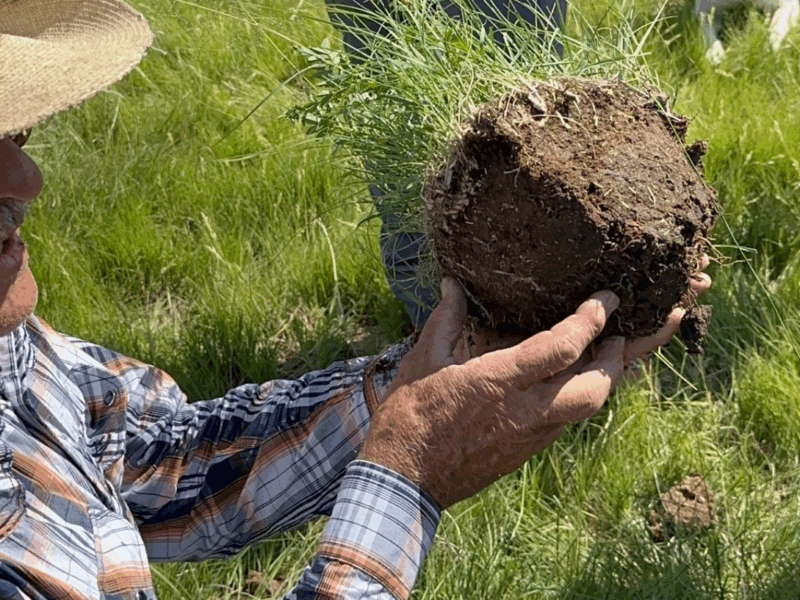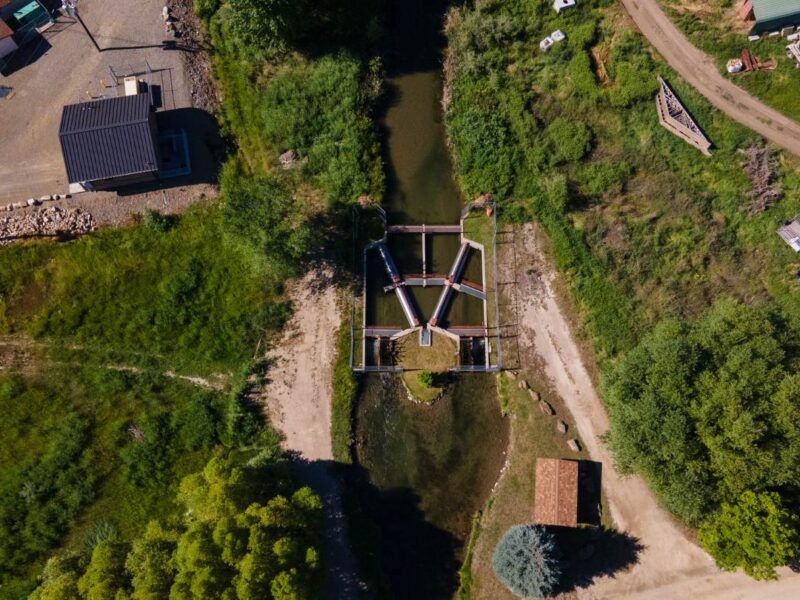Beyond Scarcity: Can we restore vitality in a drying West?
The West is used to drought. Aridification, however, is a whole other level. Aridification is more than drought, more than megadrought. Think Sahara. Think Gobi.
Increasingly, this is the forecast for the American West. But it isn’t news. Alarms have been sounding about climate change, drought and aridification for more than two decades.
As the old saying goes, “water is life.” When it comes to water in the West, one simple fact stares at us from the mirror: there isn’t enough. The average annual shortfall just in the Colorado River Basin, not counting undeveloped tribal water rights, is four million acre-feet. The Rio Grande runs dry. The Ogallala Aquifer is on track to be 70% depleted by 2050.
When it comes to addressing these critical water shortages, most of the focus is on water rights and water use—how do we best conserve and divvy up the remaining water? We find ourselves fighting amidst increasing scarcity. Urbanites point at farmers. Farmers point at the food on our plates and the sprawling subdivisions, the green lawns.
Yet what if it were possible to reverse this trend? What if we could slow or stop aridification and actually increase water supplies? What if prevailing wisdom and policy around water conservation and water use are taking us in the wrong direction?

We need to consider the relationships between land, water, life and climate at all scales. We need a unified vision for the West centered
not on scarcity but on restored vitality.
New ways of thinking about water
The truth is that we don’t know yet. However, intriguing science and innovative projects around the world are raising important questions about the incredibly complex relationships between land, water, life and climate.
For example, water managers and policy makers in the West tend to count evapotranspiration (moisture that transpires and evaporates from water bodies, plants and soil), as a net loss to local and regional water supplies. As a result, current water management strategy often seeks to minimize evapotranspiration by limiting the number of plants on the landscape, including agricultural crops, trees and other native vegetation.
The approach is running afoul of both farmers and conservationists, but for different reasons. Municipal water users and conservationists are calling for reductions in agricultural water use and establishing financial incentives for farmers to fallow land and otherwise limit consumptive use, 99.9 percent of which is attributed to evapotranspiration. Farmers are pushing back, concerned not only with the effects on the agricultural economy and food supply, but also about adverse impacts on soil and watershed health.
In the meantime, many of the same conservationists seeking to limit agricultural production are also calling for restoring natural vegetation in degraded watersheds and riparian systems. This has raised concerns from farmers in some areas that slowing water and restoring natural vegetation upstream will decrease available water for irrigation downstream. In 2023, Colorado passed legislation attempting to find a balance between the need to restore impaired stream systems and the potential impacts of resulting transpiration and evaporative losses on agricultural water users.
Following this line of thought, the fewer plants on the landscape, the more water available downstream. Taken to its logical conclusion, this could imply that one solution to the present water shortage would be to remove as much vegetation from our watersheds as possible, including forests, rangelands, woodlands, wetlands and riparian plants—a suggestion most of us would find absurd.

Water cycles
What is missing in many of these discussions is the bigger picture of the hydrologic cycle. According to the National Oceanic and Atmospheric Administration (NOAA), “The hydrologic cycle involves the continuous circulation of water in the Earth-Atmosphere system. At its core, the water cycle is the motion of the water from the ground to the atmosphere and back again. Of the many processes involved in the hydrologic cycle, the most important are: evaporation. transpiration.” This cycle not only impacts weather but also climate.
The notion that “rain follows the plow” died in the Dust Bowl, along with the vast prairie it helped to destroy. Today, however, the idea that we can induce rain through land management is making a comeback. Not only are plants essential for our ecosystems, but they are associated with cooler temperatures and higher levels of moisture, humidity and precipitation. Is the greenery a result of precipitation, a cause of precipitation or a combination of the two? Innovative projects and research around the world, and right here in the American West, are producing intriguing results. Are these mirages in the desert or do they hold real promise?
Take, for example, research by the late European meteorologist Millan Millan, who connected the disappearance of rain in portions of the Mediterranean to the loss of vegetation in the uplands. Or take the study “Trees, forests and water: Cool insights for a hot world” by David Ellison and colleagues, which highlights the crucial role of forests and evapotranspiration in water and climate cycling and calls for broader and more integrated policy-making frameworks to address these complex interactions. A new study by scientists in China on precipitation in response to the famous regreening of the Loess Plateau finds regreening did increase water yield, while also cautioning against simplistic conclusions.
A common, emerging theme in much of the research we reviewed is that scale matters: both the scale of projects and the geographic scale of the evaluation. Increased vegetation and evapotranspiration may, in fact, result in increased rain somewhere, but that rain may fall in a different watershed. At a very local level, transpiration may be a net loss while at a regional level, depending on the size, nature and location of the area, it could help stem aridification.
A study out of Stockholm by P. W. Keys et al. proposes a concept of “precipitationsheds.” The research suggests that upwind areas of evaporation, such as forests, contribute moisture for precipitation that falls downwind.
These studies strongly suggest that we need to consider the relationships between land, water, life and climate at all scales. We also need to consider both short-term and long-term potential outcomes of management decisions. Are we sacrificing tomorrow’s rain for today’s streamflow?
In the meantime, land managers the world over are experimenting with regreening projects. The most famous examples are the “Great Green Wall” of the Sahel in Africa and China’s Loess Plateau project, documented by John D. Liu in his film, “Hope in a Changing Climate.” But there is much to be hopeful for in the American West as well.


Long-term flow
Here, landowners and conservationists are using techniques such as regenerative grazing, flood irrigation and low-tech process-based restoration (LTPBR) to restore vegetation and slow movement of water on the landscape to allow for greater absorption and infiltration. In some cases, these projects are credited with restoring stream flows and biodiversity, moderating floods, increasing soil carbon sequestration and enhancing agricultural productivity. In this issue of On Land we look at a few of those case studies. They are but a small sampling of a growing movement underway throughout the West and beyond.
If there is one takeaway from all of this, it is that we cannot afford to look at water through too narrow or short-sighted a lens. Local solutions are important but must be undertaken in the context of larger regional considerations.
We are used to the idea that water is for fighting, but it should be the opposite. Water is such a precious resource it demands the best of us. Cooperation is what makes it possible for humans to survive. We need a unified vision for the West centered not on scarcity but on restored vitality. This could include coordinated urban-rural partnerships to research and improve the hydrologic cycle through better land management, water harvesting and improved storage. For this we would do well to turn to Aldo Leopold who observed, “A thing is right when it tends to preserve the integrity, stability and beauty of the biotic community. It is wrong when it tends otherwise.”
Sorry, the comment form is closed at this time.





Melanie Lawrence
Leslie, it was wonderful getting to speak to you at the Malpai Borderlands Group science conference! I really appreciate that in this article you take on the idea of scarcity and the need for cooperation to find possible solutions. I believe that adaptive management principles need to be applied to create or restore the resilient landscapes going forward. I try to pass along all of the WLA’s articles to my friends who are still stuck in the ” culture of conflict” as Courtney White termed it. Adaptive Management requires collaboration and I am heartened by WLA’s commitment to collaboratively managing our Western lands!
Carl Struck
Leslie, I’m so glad WLA is focusing this issue on the hydrologic cycle. This is a topic that is so important here in the arid West and is often misunderstood or misrepresented. For the past few years I’ve been a member of an international online community called WaterStories which is a great place to gather information and seek support for any landowners interested in improving their relationship with water on their land. As a small private forest manager it has been a great place for me to find answers and drill down on an issue with so many moving parts. I highly recommend it! Thanks for shinning a light on the problems associated with a “scarcity” view point.
Ashley Rood
Love this piece Lesli. Especially the closing focused on scale and cooperation: “we cannot afford to look at water through too narrow or short-sighted a lens. Local solutions are important but must be undertaken in the context of larger regional considerations” This theme is coming up in my work a lot including a recent training I attended on climate resillience for TA providers. Thank you!